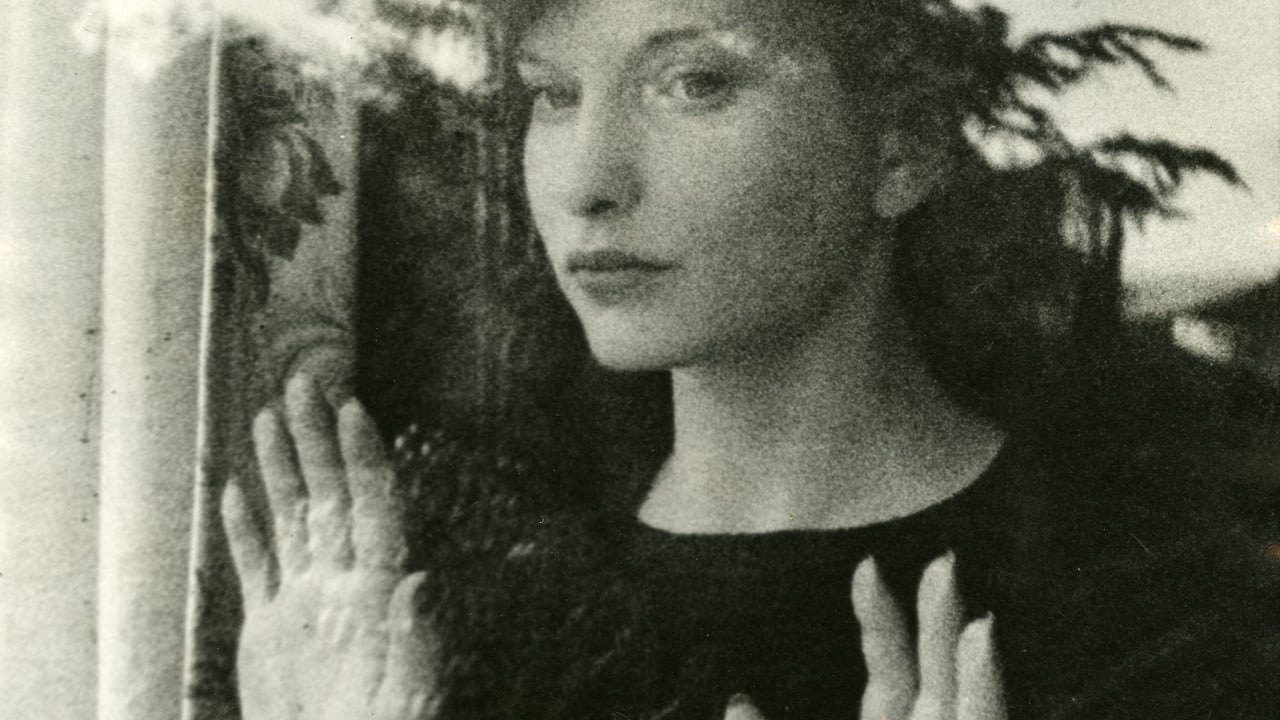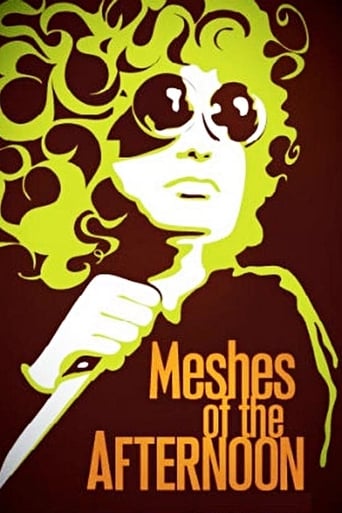



the leading man is my tpye
Let's be realistic.
A Disappointing Continuation
The film's masterful storytelling did its job. The message was clear. No need to overdo.
View MoreI got to know this film from IMDb's "Similar movies, movies you may like" link, and what I'd expected was beyond my expectation. Way ahead of times editing and effect including "slow mo effect", brilliant score, haunting imagery and a captivating story-line in just 13mins.The movie starts by introducing of the actress "Maya Deren" herself and the core elements of the story with an emphasized shot on each of them, and each item might symbolize something, we get flowers, a key, a knife in a loaf of bread, a telephone. After the introduction "Maya Deren" went up to a room, stopped the record player and the film went silent, leading me to believe that the film's previous source of music came from that record player. After switching off the record player Maya Deren seemingly took a nap and things get crazy when the record started playing again without manual assistance, or so i thought and Maya Deren meeting a cloak figure with a mirror for a face, like in a dream or an out of body experience, stuck in an endless loop as the story-progress, and ultimately leading to a brilliant conclusion.Don't miss this.
View MoreI had the pleasure of watching Maya Deren's Meshes of the Afternoon just minutes after watching Luis Buñuel's Un Chien Andalou. And although Buñuel's movie is the most famous and most influential of the two, I not only enjoyed Deren's more but I also found it more intelligent and better made.Although Buñuel's movie rejects any narrative and interpretation, Deren's movie is a little narrative of a nightmare, plunging the viewer deep into a dark, intimate world full of symbols, scary figures and elliptic storytelling. All in all, it's much more dreamlike than Un Chien Andalou.A hand leaves a flower on a pathway. A woman picks it up. Enters a house. Objects are out of place. She falls asleep. The narrative begins anew, with small differences. Then it starts again, each time oddly familiar but always with differences. At one point the viewer asks himself if the woman isn't just dreaming about herself in an endless loop? Maybe she is, maybe she's not. The movie doesn't explain anything, it merely presents a situation and invites the viewer to think about what it means. The tone of the movie is depressing and austere, and was originally made without sound. I enjoy weird movies, and I can say I've seldom seen one that so easily captured the nature of a nightmare, by being terrifying without really showing anything terrifying. Like a painting by Escher or a short-story by Jorge Luis Borges, Meshes of the Afternoon is a work of art that transcends reality and touches the viewer on a level above language and reason.
View MoreMeshes Of The Afternoon Meshes, according to Deren, is "concerned with the inner realities of an individual and the way in which the subconscious will develop, interpret and elaborate an apparently simple and casual occurrence into a critical emotional experience."Have you ever stopped to wonder, when you see and touch a flower, what happens inside? Unless you are in purely botanical mode, it may very likely spark off something in your subconscious. The breath of spring. The beauty and harmony of nature. Perhaps something given with affection and gentleness. Maybe even a token of romance?Maya Deren's wildly seminal work, Meshes Of The Afternoon, begins when a rather artificial looking hand places a flower on a pathway. The hand (and attached arm) pop out of existence, immediately alerting us to the fact that this is not a work of literal storytelling. The symbols of the next 14 minutes drill holes into our subconscious, where images speak louder than words, creating one of the most famous short films of all time.A woman picks up the flower on her way home. At her doorstep, she drops her key. Once inside, she falls asleep in an armchair. Her dream-self sees her former self approaching the house. But the flower is being carried by a hooded figure whose only face is a mirror. Giving chase brings her no closer to the hooded figure – it just brings her to her doorstep. This time, when she ascends the stairs, we see her expression. No longer carefree, she is watchful, slightly suspicious.A breadknife, previously cutting bread, lies on the steps. A phone off the hook, and the knife hidden in the bed. She sees her sleeping form and a gramophone playing endlessly with no sound. Through the cracked window she sees herself giving chase to the hooded figure and takes the key from her mouth. We look again. It become a knife with which she confronts two other images of herself. Eventually a man enters the picture.The sight or touch of a flower reminds us that the subconscious mind works in symbols. Like images from a dream, the flower can bring certain feelings to the surface. Similarly a knife may be just an implement, or an implement with which we can feed ourselves, or hurt ourselves. Meshes Of The Afternoon soon evokes Freudian implications. Is the man coming home from work the fulfillment of her romantic dreams or their frustration? As an outside force, he can be a blessing or a threat, just as a mirror can show oneself or a reveal a hidden person. But Deren hotly denied it was surrealist. Whereas the surrealist is parodic, Deren is deadly serious. To her, their work was like doodling with symbols. Her polemics castigated surrealists for 'abnegating the agency of consciousness.' The role of the artist, she said, had degenerated. "His achievement, if any, consists in a titillating reproduction of reality which can be enjoyed in air-conditioned comfort by an audience too comatose to take the exercise of a direct experience of life."The music (by Deren's third husband, and added 16 years later) adds to the sense of rising paranoia and dread. Its ritualistic feel has persuaded some commentators to suggest that the double characters and constantly changing identities stem from Deren's interest in Voodoo (her writings on the subject are still a leading authority - she was later initiated as a Voodoo priestess). Yet it wasn't until 1947, four years later, that Deren received a Guggenheim Foundation Fellowship that enabled her to begin visiting Haiti to study Voodoo. More likely they are indicative of an early grasp of psychology, a deep interest of hers and one which she shared with her father.To signify the hooded figure as the Grim Reaper is also to trivialize and pigeon hole a symbol capable of many equally valid interpretations. Some feminist readings centre on the frustration of a woman left at home all day. Yet we can also look at it in the sense of someone coming to know themselves and risking their sanity in the process.On a technical level, Meshes Of The Afternoon, shot on a miniscule budget, has almost non-existent production values and may fail easily to engage modern audiences. It has total disregard for Hollywood convention (the word 'Hollywood' in the opening titles could even be read as frustration with the barrenness of the industry there). There is an superficial similarity with works by Shirley Clarke or the early surrealism of Bunuel. Structurally, we can see its influence in Lynch's Lost Highway, where no explanation is given or needed for one thing (or person) turning into another (though some of the explicit symbols are explored more thoroughly in Lynch's later works, Mulholland Drive and Inland Empire). By understanding Meshes Of The Afternoon, such 'populist' surrealism becomes child's play. As a journey of self-discovery with deep overtones, it follows a similar (though less tragic) theme to Nina Menkes' Phantom Love.Some commentators have cast doubt over whether Deren was the primary artistic force in the film, saying it is largely the work of her husband Alexander Hammid. Deren's biographers disagree. Certainly it is her most famous, complex and mature piece of cinema, although her next film, At Land, maintained some of the enigmatic structure of Meshes Of The Afternoon. Later, her works would focus more on dance-film (except, perhaps, for her documentary on Voodoo, Divine Horsemen: The Living Gods of Haiti). But whoever was behind Meshes, there are few segments of 14 minutes that remain so disturbing, so infinitely re-watchable, and so influential to this day.
View MoreI like watching an occasional experimental Luis Buñuel movie and I like them for what they are. I can also see the art of the it, just like this movie is definitely a piece of art. I could say that I liked this movie- and found it to be just as appealing as a Luis Buñuel movie though. But a thing is that Buñuel was already making these type of movies in the '20's, so calling this movie, which is from 1943, ahead of its time is a pretty ridicules statement in my opinion. There always is boss above boss.The movie can be seen as being stuck in a nightmare. A Lot of images within the movie have a nightmarish looking over them, in which a woman sees her own death, only to wake up after it seeing the things she dreamed about really happening. This movie of course doesn't feature your average storytelling but nevertheless because of this the story perhaps even work out all the more effective. The movie doesn't feature any dialog in it and lets all of the images speak for them selves. Some moments within the movie can of course be interpreted in different ways by different people but that is part of the appeal of an experimental movie of this kind.A nice little surrealistic movie, from and with Maya Daren.9/10http://bobafett1138.blogspot.com/
View More